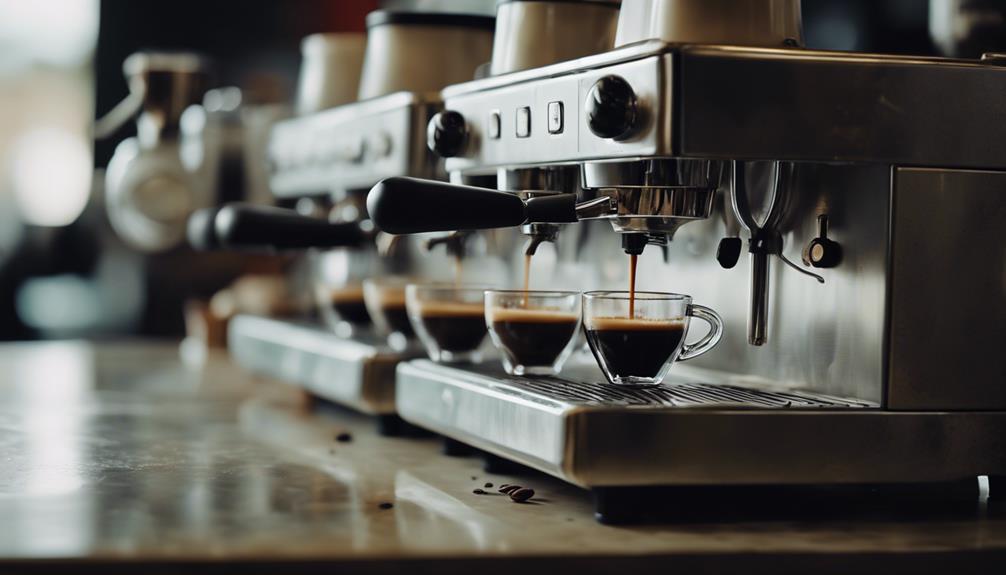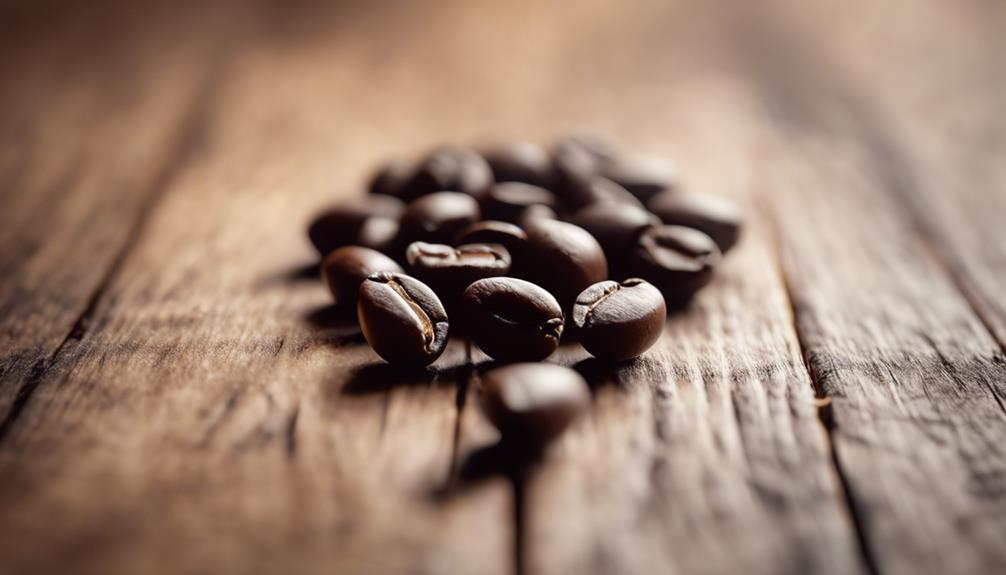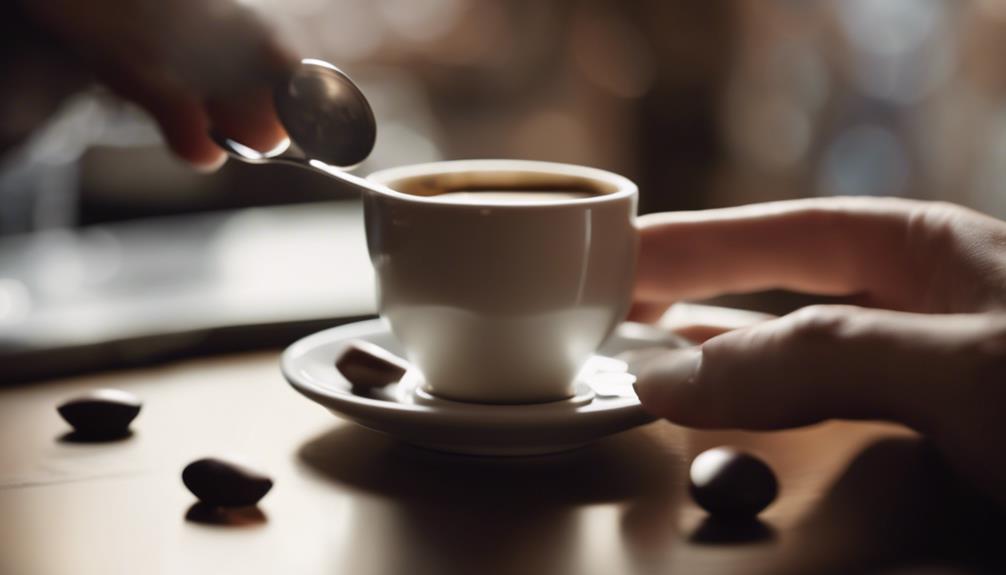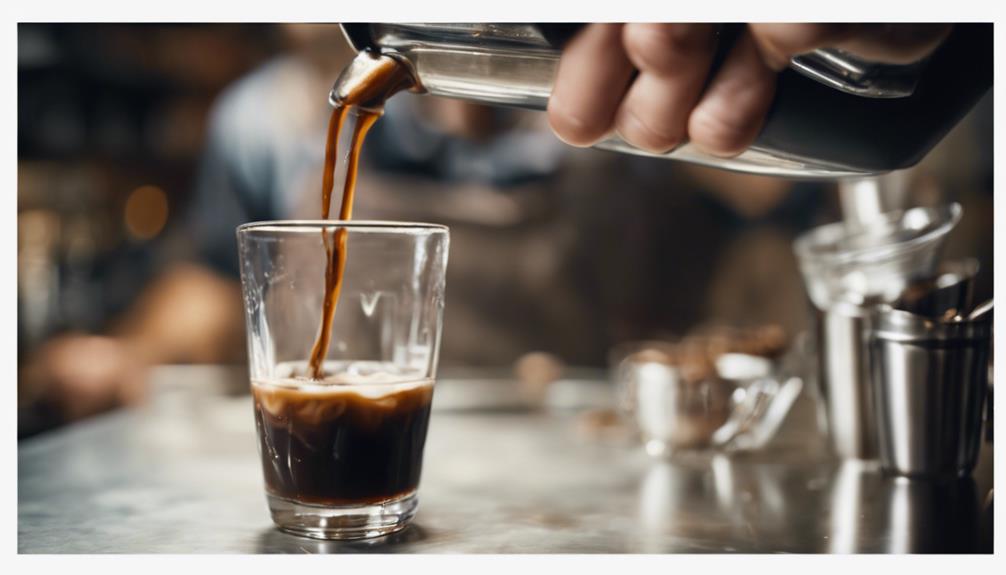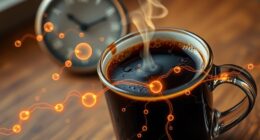If your espresso lacks creaminess, consider these factors: stale beans, improper tamping, inconsistent water pressure, wrong coffee-to-water ratio, a dirty machine, low-quality beans, or unsuitable grind size. Fresh beans with proper tamping, consistent water pressure, right ratios, clean equipment, and quality beans are key. Practice precision in every step for a creamy espresso. Mastering the espresso brewing process takes time and attention to detail. Start by checking the freshness and quality of your beans, ensuring they are properly ground and tamped. It’s also important to maintain a clean machine and monitor water pressure for consistency. By focusing on each factor that contributes to a creamy espresso, you can fine-tune your brewing technique and achieve the perfect shot every time.
Key Takeaways
- Stale or low-quality beans affect crema richness.
- Incorrect tamping pressure can lead to weak crema.
- Inconsistent coffee-to-water ratio impacts crema quality.
- Improper grinder setting affects crema texture.
- Dirty equipment hinders creamy crema production.
Stale Coffee Beans
Stale coffee beans greatly impact the creaminess of your espresso due to their reduced carbon dioxide levels essential for forming a thick crema. When coffee beans are freshly roasted, they contain high levels of carbon dioxide gas. This gas is vital for creating the luxurious crema on your espresso.
However, as beans age and become stale, they gradually lose this carbon dioxide content through oxidation. As a result, when you use stale beans to brew your espresso, the crema formed tends to be lackluster and thin.
To make sure that your espresso has the desired creamy crema, it's important to use freshly roasted coffee beans. These beans retain their carbon dioxide levels, allowing for the proper extraction of flavors and oils during the brewing process.
Incorrect Tamping Technique
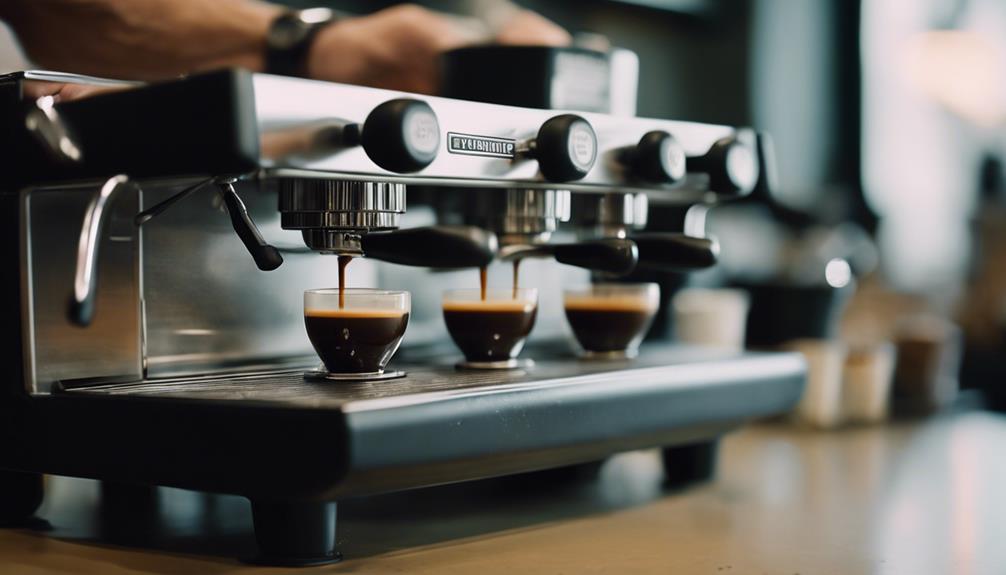
When preparing your espresso, make sure that your tamping technique is correct to achieve the desired creamy crema.
Tamping too lightly can lead to under-extraction, resulting in a weak crema. On the other hand, over-tamping can cause channeling, where water bypasses the coffee grounds, leading to uneven extraction and poor crema quality.
To guarantee a consistent extraction, maintaining the right tamping pressure is essential for even water distribution through the coffee puck, which is necessary for a creamy crema.
Consider using a calibrated tamper to help you maintain a consistent tamping pressure for ideal crema extraction.
Additionally, tamping at a slight angle can help create a more even surface, promoting better water flow and enhancing the quality of the crema.
Inconsistent Water Pressure
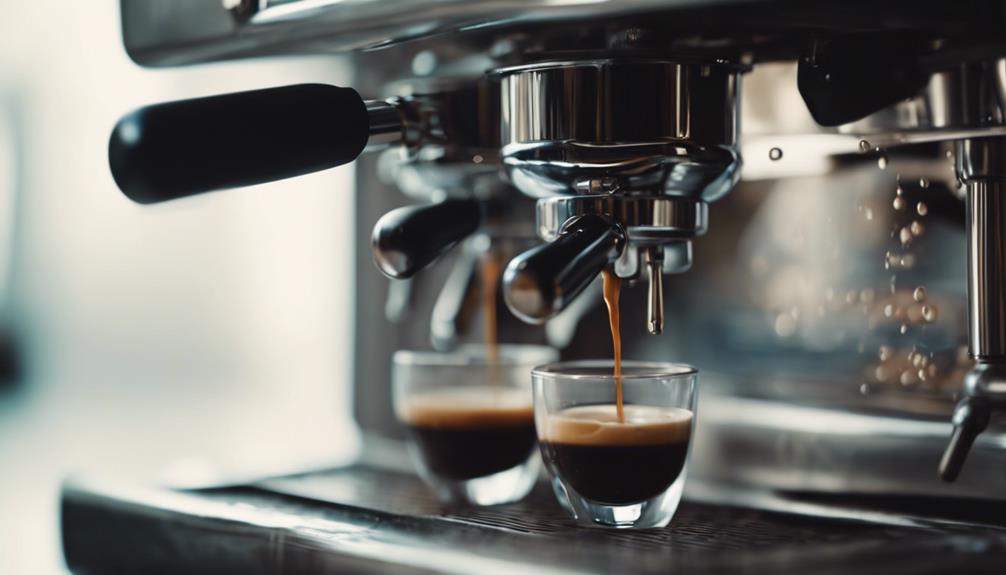
Inconsistent water pressure poses a significant challenge for achieving a rich and creamy crema in your espresso shots. Adequate water pressure, around 9 bars, is vital for creating that perfect layer of crema on top of your espresso. When the water pressure in your espresso machine fluctuates, it can lead to uneven extraction, resulting in under-extracted or over-extracted shots with minimal crema. Machines with inconsistent water pressure may struggle to produce the desired creamy and flavorful espresso that you crave. Monitoring and maintaining a consistent water pressure level is crucial for achieving a smooth and velvety crema on your espresso.
| Espresso Machine | Water Pressure | Crema | Inconsistent |
|---|---|---|---|
| Important for | Around 9 bars | Rich layer | Hinders |
| even extraction | Vital | of crema | Desired |
| Struggles with | Fluctuating | Minimal | Monitoring |
| Producing desired | Can lead to | Flavorful | Maintaining |
Improper Coffee-to-Water Ratio

To guarantee a creamy espresso, the coffee-to-water ratio must be carefully balanced at 1:2. Deviating from this precise ratio can result in a thin crema and impact the overall flavor of your shot.
Consistency in measuring the ratio is key to achieving the desired richness in your espresso crema.
Water-Coffee Imbalance
Maintaining a precise 1:2 coffee-to-water ratio is vital for achieving a creamy espresso shot with a rich crema. When the balance between coffee and water is off, the quality of your espresso can suffer.
Here are a few key points to remember:
- Thin Crema: Deviating from the 1:2 ratio can lead to a thin crema on top of your espresso, robbing you of that velvety texture and intense flavor you crave.
- Flavor Impact: A disrupted coffee-to-water ratio doesn't just affect the crema; it also alters the overall taste of your espresso, potentially resulting in a less satisfying experience.
- Consistent Measurements: Using a scale to guarantee consistent measurements of both coffee and water is essential for achieving a uniform crema quality across all your espresso shots. This attention to detail can make a significant difference in the richness and thickness of the crema in your cup.
Ratio Precision Matters
When your coffee-to-water ratio isn't precise, it directly impacts the quality of your espresso shot, particularly the richness of the crema.
To achieve a balanced espresso shot with a rich crema, maintaining a consistent 1:2 coffee-to-water ratio is essential. Deviating from this recommended ratio can lead to thinner crema and an unbalanced taste in your espresso.
Using a scale for consistent measurements is key to ensuring uniform crema quality across multiple shots. The thickness and richness of crema in your espresso shots are greatly influenced by the coffee-to-water ratio you use. Hence, precise measurement plays a critical role in achieving the best crema quality.
By paying attention to the ratio and ensuring consistent measurements, you can enhance the overall quality and flavor profile of your espresso shots.
Creaminess Correlates To Ratio
Achieving a creamy espresso shot with rich crema hinges on adhering to the proper 1:2 coffee-to-water ratio. When it comes to the creaminess of your espresso, the coffee-to-water ratio plays a critical role. Here's why:
- Consistency is Key: Deviating from the 1:2 ratio can lead to a less creamy crema on your espresso. To guarantee a velvety texture, maintaining a precise ratio is essential.
- Thick and Creamy Crema: The coffee-to-water ratio plays a crucial role in the thickness and creaminess of the crema in your espresso shot. A 1:2 ratio helps achieve a rich and indulgent crema that enhances the overall espresso experience.
- Full-Bodied Espresso: By sticking to the 1:2 ratio, you can enjoy a full-bodied espresso shot with a velvety and creamy crema on top. This balance of coffee and water results in a harmonious blend that elevates the taste and texture of your drink.
Dirty Espresso Machine
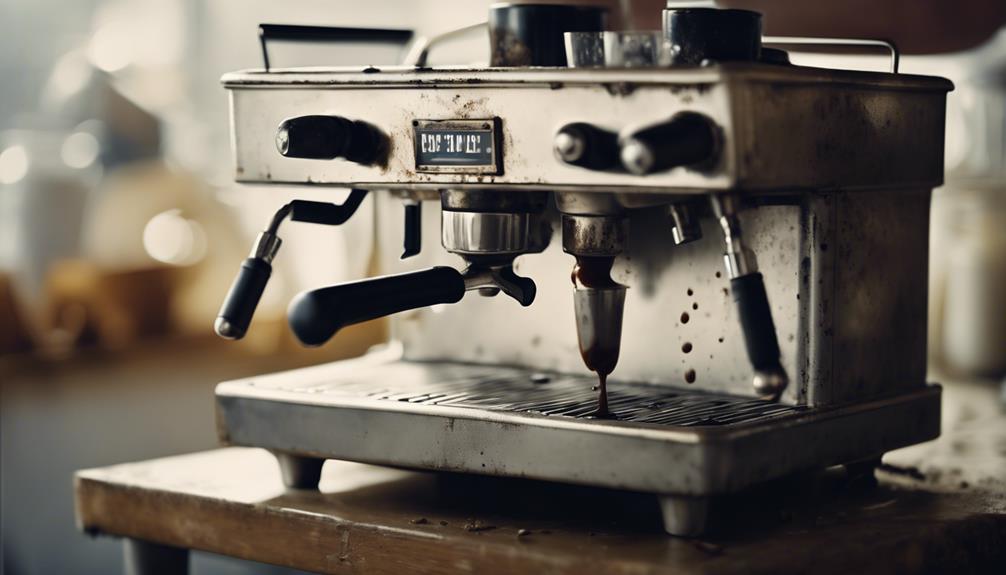
A grimy espresso machine can hinder the production of creamy crema due to its impact on water flow and temperature regulation. When your espresso machine is dirty, residue buildup from oils and minerals can clog the internal components, leading to poor crema quality in your shots.
Regular cleaning and descaling of your espresso machine are essential to prevent these issues and maintain peak crema production. Dirty group heads and portafilters can also contribute to uneven extraction, further affecting the formation of a rich crema on your espresso.
To maintain consistent and creamy crema in your espresso shots, it's important to prioritize the proper maintenance of your espresso machine. By keeping your machine clean and well-maintained, you can enjoy high-quality espresso with a velvety crema every time you brew.
Low-Quality Coffee Beans
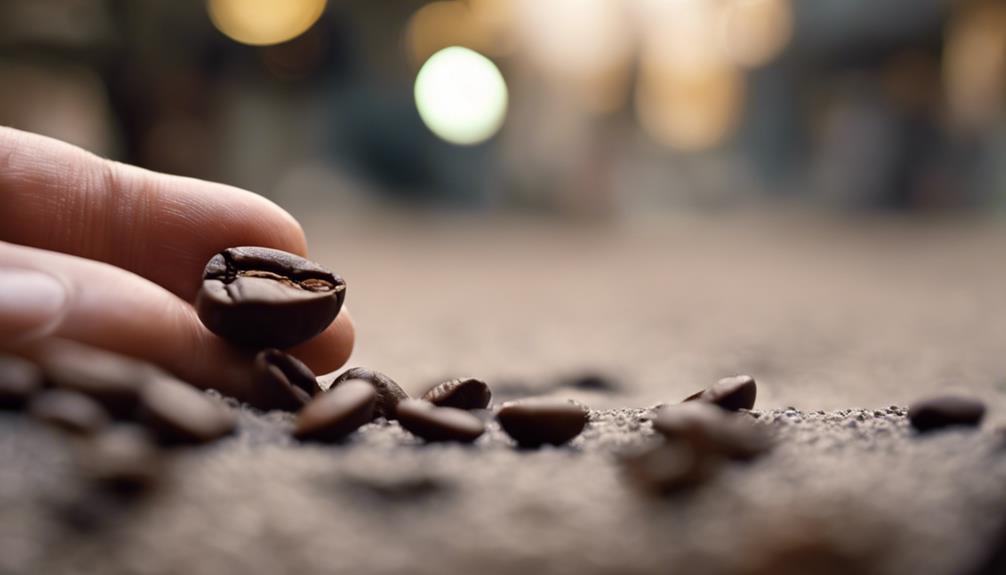
Poor-quality coffee beans can greatly affect the crema production in your espresso shots. When it comes to the beans you use for your espresso, here are some key factors to take into account:
- Freshness Matters:
Opt for freshly roasted coffee beans to make sure they retain their essential oils and carbon dioxide content, which are vital for creating that creamy layer of crema on top of your espresso.
- Proper Storage:
Stale or improperly stored beans can lose their carbon dioxide, leading to a lackluster crema. Make sure to store your beans in a cool, dark place and use them within a reasonable timeframe to preserve their quality.
- Quality of Roast:
The roast level of your coffee beans plays a significant role in crema production. Beans with low oil content or those that have been roasted inadequately may not produce the desired creamy texture in your espresso shots. Opting for high-quality, well-roasted beans is essential for achieving a rich and flavorful crema.
Unsuitable Grind Size
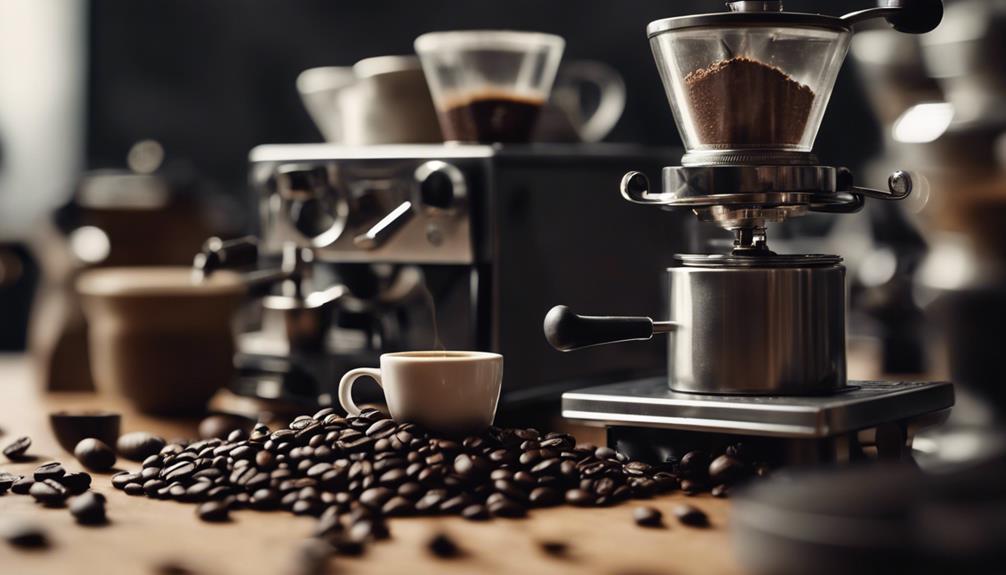
Improper grind size can greatly impact the quality of your espresso shots, affecting crema production and overall flavor profile. When the coffee is ground too finely, it can lead to a compacted puck in the portafilter, restricting water flow during extraction and resulting in poor crema formation.
Using pre-ground coffee may introduce inconsistencies in particle size, further affecting crema quality. To address these issues, adjusting your grinder to a coarser setting can help improve water extraction, leading to a richer crema on your espresso shot.
Additionally, utilizing a dual wall filter basket can assist in compensating for unsuitable grind sizes, promoting better crema development. Remember, even and firm tamping, along with maintaining proper water pressure, are essential factors in overcoming challenges related to grind size and achieving ideal crema in your espresso.
Frequently Asked Questions
Why Is My Espresso Shot Not Creamy?
If your espresso shot lacks creaminess, several factors could be at play.
Inconsistent tamping pressure, varying particle sizes in pre-ground coffee, and inadequate water pressure below 9 bars may hinder crema formation.
Additionally, overheating coffee grounds from excessive tamping can impact crema development.
Achieving a creamy crema requires a balance of water temperature, pressure, and grind consistency.
Ensuring these elements align can help improve the creaminess of your espresso shots.
How Do I Make My Espresso More Creamy?
To make your espresso more creamy, there are several key steps you can follow:
- Adjust the grind size finer.
- Use freshly roasted beans with higher carbon dioxide levels.
- Maintain 9 bars of water pressure.
- Aim for a 1:2 coffee-to-water ratio.
Experiment with tamping pressures to optimize water flow. These steps will help you achieve a rich and creamy espresso shot.
Consistency in these practices will enhance the crema formation, providing you with a satisfying espresso experience.
What Causes Poor Quality Crema?
To achieve creamy espresso, focus on maintaining consistent tamping pressure, proper water temperature, fresh coffee beans, correct grind size, and sufficient machine pressure.
Inconsistent tamping or improper water temperature can lead to poor crema. Stale beans, incorrect grind size, or insufficient machine pressure also affect crema quality.
Why Is My Espresso Mostly Foam?
If your espresso is mostly foam, it could be due to several factors. Make sure your grinder isn't set too coarse, as this can lead to excessive foam. Additionally, check that your coffee grounds are evenly distributed in the portafilter before tamping. Inconsistent tamping can also result in excessive foam. Another factor to consider is the type of espresso beans being used. Some beans naturally produce more foam than others. When the espresso is properly brewed, the benefits of espresso powder are enhanced, including a rich and flavorful taste that is emphasized by the strong crema on top.
Proper tamping pressure is essential to prevent too much air in the shot. Check the water temperature and the quality of your beans.
Additionally, confirm the extraction process maintains sufficient pressure. These steps can help you achieve a creamy espresso with the perfect balance of crema.
Could Not Creamy Espresso be Harmful for Health?
While espresso is a good option for many coffee lovers, it’s important to be cautious with creamy variations. Adding excessive cream and sugar can increase the drink’s caloric and fat content, potentially leading to negative health effects. It’s best to enjoy espresso in moderation and opt for healthier alternatives when possible.
How Can I Ensure My Espresso Is Creamy Like a Cappuccino?
If you want to ensure your espresso is creamy like a cappuccino, the key differences espresso cappuccino lie in the milk frothing process. For a creamy espresso, use steamed milk with a frothy layer on top, similar to a cappuccino. This will give your espresso a velvety texture and rich flavor.
Can Adding Brown Sugar Shake Help Make My Espresso Creamy?
Looking to make your espresso creamy? Try a unique twist with a brown sugar shaken espresso recipe. Adding brown sugar and shaking it with your espresso can create a smooth, creamy texture that enhances the flavor of your drink. Give it a try and elevate your coffee experience.
Can I Make My Espresso Creamy Using Brown Sugar Oatmilk?
Yes, you can make your iced oatmilk espresso drink creamy using brown sugar oatmilk. The richness of the brown sugar oatmilk adds a creamy texture to the espresso, creating a delicious and satisfying drink. Give it a try for a unique and indulgent twist on your usual espresso beverage.
Conclusion
To sum up, if your espresso lacks creaminess, it could be due to various factors such as stale coffee beans, improper tamping technique, or low-quality coffee beans. Remember, maintaining a clean espresso machine and using the correct grind size are essential for a creamy espresso. Additionally, investing in a high-quality espresso machine and grinder can also greatly improve the creaminess of your espresso. Experimenting with different espresso brewing methods, such as using a bottomless portafilter or adjusting the brewing pressure, can also help achieve a creamier result. Ultimately, finding the perfect combination of factors that work best for your espresso setup and personal taste will result in a delicious, creamy cup of espresso.
Did you know that a study found that 80% of the flavor in espresso comes from the coffee beans themselves? By addressing these issues, you can enjoy a delicious and creamy espresso every time.
